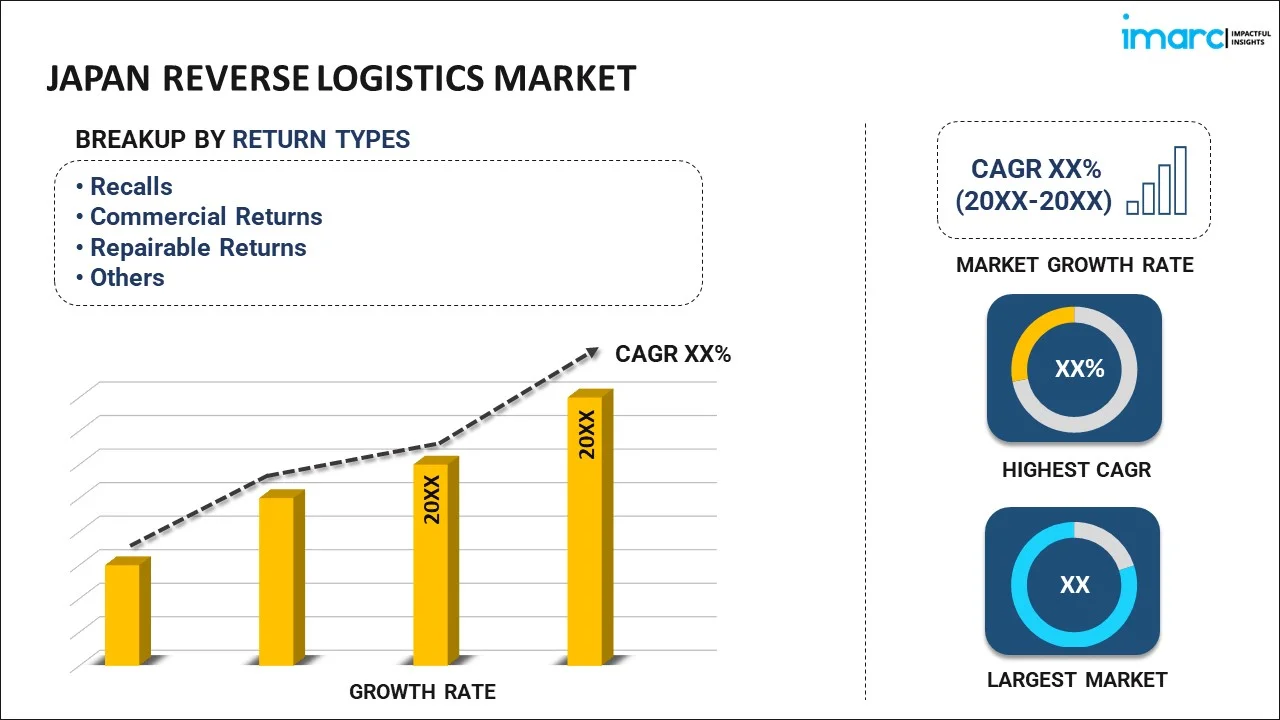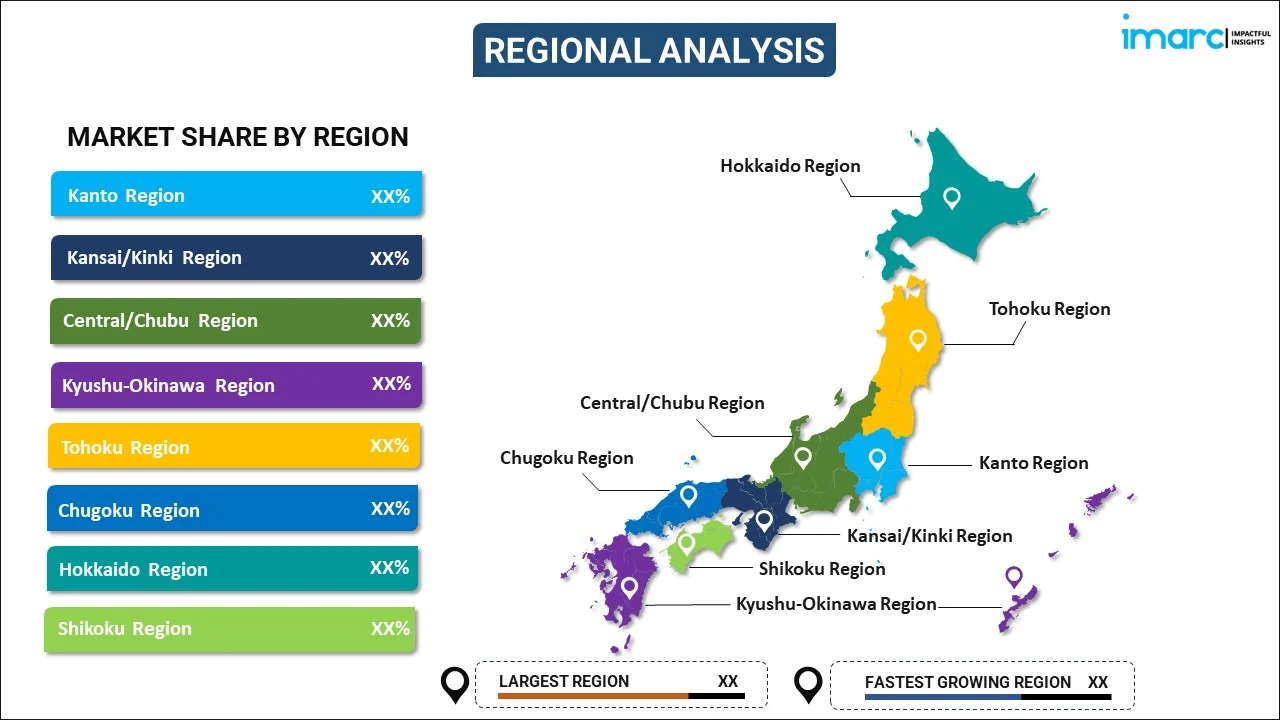
Japan Reverse Logistics Market Report by Return Type (Recalls, Commercial Returns, Repairable Returns, End-of-Use Returns, End of life Returns), Service (Transportation, Warehousing, Reselling, Replacement Management, Refund Management Authorization, and Others), End User (E-Commerce, Automotive, Pharmaceutical, Consumer Electronic, Retail, Luxury Goods, Reusable Packaging), and Region 2025-2033
Market Overview:
Japan reverse logistics market size reached USD 45.5 Billion in 2024. Looking forward, IMARC Group expects the market to reach USD 80.7 Billion by 2033, exhibiting a growth rate (CAGR) of 6.08% during 2025-2033. The increasing environmental consciousness among consumers and businesses, the implementation of strict regulations and policies to promote responsible waste management, and the emerging technological advancements in data analytics and tracking systems represent some of the key factors driving the market.
|
Report Attribute
|
Key Statistics
|
|---|---|
|
Base Year
|
2024 |
|
Forecast Years
|
2025-2033
|
|
Historical Years
|
2019-2024
|
| Market Size in 2024 | USD 45.5 Billion |
| Market Forecast in 2033 | USD 80.7 Billion |
| Market Growth Rate (2025-2033) | 6.08% |
Reverse logistics refers to the process of managing the return, remanufacturing, refurbishing, and recycling of products and materials after they have been sold and used by consumers. It is an essential aspect of supply chain management that focuses on handling goods in reverse flow, as opposed to the traditional forward flow of products from manufacturers to consumers. It minimizes waste, reduces the carbon footprint, and promotes sustainability which is achieved through various activities within the reverse logistics process. Returns management is a primary component of reverse logistics, when customers return products for various reasons, companies must efficiently handle these returns. This involves assessing the condition of the returned items, determining whether they can be resold as-is or need refurbishing, and ensuring proper disposal for items that cannot be salvaged. It also involves remanufacturing disassembling used products, repairing or replacing components, and then reassembling them to the new condition which extends the product's lifecycle and reduces the demand for new raw materials, making it an environmentally friendly practice. It typically involves less extensive repairs and focuses on improving the product's appearance and functionality. Additionally, recycling involves the extraction of valuable materials from used products that can be reused in the manufacturing of new products, reducing the need for virgin resources and decreasing the environmental impact.
Japan Reverse Logistics Market Trends:
The market is primarily driven by the increasing environmental consciousness among consumers and businesses. In addition, the rising emphasis on sustainability and reducing waste led industries to adopt reverse logistics practices to manage product returns, recycling, and reusing materials, influencing market growth. Moreover, several advancements in technology, such as data analytics and tracking systems made it easier for companies to manage their reverse logistics operations efficiently, representing another major growth-inducing factor. Also, real-time tracking of returned products, inventory management, and routing optimization are now possible, contributing to market growth. Besides this, the implementation of strict regulations and policies to promote responsible waste management and recycling is accelerating the market growth. Along with this, companies are legally obligated to handle returns and dispose of products in an environmentally friendly manner which has incentivized the adoption of reverse logistics solutions. Apart from this, the growing e-commerce sector in Japan is driven by changing consumer preferences and increased internet penetration, increasing online shopping naturally leading to a higher volume of product returns, requiring efficient reverse logistics systems to manage the influx, contributing to the market growth. Furthermore, the growing automotive sector has adopted reverse logistics for the return and recycling of end-of-life vehicles and their components, influencing the market growth.
Japan Reverse Logistics Market Segmentation:
IMARC Group provides an analysis of the key trends in each segment of the market, along with forecasts at the country level for 2025-2033. Our report has categorized the market based on return type, service, and end user.
Return Type Insights:

- Recalls
- Commercial Returns
- Repairable Returns
- End-of-Use Returns
- End of life Returns
The report has provided a detailed breakup and analysis of the market based on the return type. This includes recalls, commercial returns, repairable returns, end-of-use returns, and end of life returns.
Service Insights:
- Transportation
- Warehousing
- Reselling
- Replacement Management
- Refund Management Authorization
- Others
A detailed breakup and analysis of the market based on the service have also been provided in the report. This includes transportation, warehousing, reselling, replacement management, refund management authorization, and others.
End User Insights:
- E-Commerce
- Automotive
- Pharmaceutical
- Consumer Electronic
- Retail
- Luxury Goods
- Reusable Packaging
The report has provided a detailed breakup and analysis of the market based on the end user. This includes E-commerce, automotive, pharmaceutical, consumer electronic, retail, luxury goods, and reusable packaging.
Regional Insights:

- Kanto Region
- Kansai/Kinki Region
- Central/ Chubu Region
- Kyushu-Okinawa Region
- Tohoku Region
- Chugoku Region
- Hokkaido Region
- Shikoku Region
The report has also provided a comprehensive analysis of all the major regional markets, which include Kanto Region, Kansai/Kinki Region, Central/ Chubu Region, Kyushu-Okinawa Region, Tohoku Region, Chugoku Region, Hokkaido Region, and Shikoku Region.
Competitive Landscape:
The market research report has also provided a comprehensive analysis of the competitive landscape in the market. Competitive analysis such as market structure, key player positioning, top winning strategies, competitive dashboard, and company evaluation quadrant has been covered in the report. Also, detailed profiles of all major companies have been provided.
Japan Reverse Logistics Market Report Coverage:
| Report Features | Details |
|---|---|
| Base Year of the Analysis | 2024 |
| Historical Period | 2019-2024 |
| Forecast Period | 2025-2033 |
| Units | Billion USD |
| Scope of the Report | Exploration of Historical and Forecast Trends, Industry Catalysts and Challenges, Segment-Wise Historical and Predictive Market Assessment:
|
| Return Types Covered | Recalls, Commercial Returns, Repairable Returns, End-of-Use Returns, End of life Returns |
| Services Covered | Transportation, Warehousing, Reselling, Replacement Management, Refund Management Authorization, Others |
| End Users Covered | E-Commerce, Automotive, Pharmaceutical, Consumer Electronic, Retail, Luxury Goods, Reusable Packaging |
| Regions Covered | Kanto Region, Kansai/Kinki Region, Central/ Chubu Region, Kyushu-Okinawa Region, Tohoku Region, Chugoku Region, Hokkaido Region, Shikoku Region |
| Customization Scope | 10% Free Customization |
| Post-Sale Analyst Support | 10-12 Weeks |
| Delivery Format | PDF and Excel through Email (We can also provide the editable version of the report in PPT/Word format on special request) |
Key Questions Answered in This Report:
- How has the Japan reverse logistics market performed so far and how will it perform in the coming years?
- What has been the impact of COVID-19 on the Japan reverse logistics market?
- What is the breakup of the Japan reverse logistics market on the basis of return type?
- What is the breakup of the Japan reverse logistics market on the basis of service?
- What is the breakup of the Japan reverse logistics market on the basis of end user?
- What are the various stages in the value chain of the Japan reverse logistics market?
- What are the key driving factors and challenges in the Japan reverse logistics?
- What is the structure of the Japan reverse logistics market and who are the key players?
- What is the degree of competition in the Japan reverse logistics market?
Key Benefits for Stakeholders:
- IMARC’s industry report offers a comprehensive quantitative analysis of various market segments, historical and current market trends, market forecasts, and dynamics of the Japan reverse logistics market from 2019-2033.
- The research report provides the latest information on the market drivers, challenges, and opportunities in the Japan reverse logistics market.
- Porter's five forces analysis assist stakeholders in assessing the impact of new entrants, competitive rivalry, supplier power, buyer power, and the threat of substitution. It helps stakeholders to analyze the level of competition within the Japan reverse logistics industry and its attractiveness.
- Competitive landscape allows stakeholders to understand their competitive environment and provides an insight into the current positions of key players in the market.
Need more help?
- Speak to our experienced analysts for insights on the current market scenarios.
- Include additional segments and countries to customize the report as per your requirement.
- Gain an unparalleled competitive advantage in your domain by understanding how to utilize the report and positively impacting your operations and revenue.
- For further assistance, please connect with our analysts.
 Inquire Before Buying
Inquire Before Buying
 Speak to an Analyst
Speak to an Analyst
 Request Brochure
Request Brochure
 Request Customization
Request Customization




.webp)




.webp)












